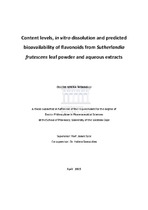| dc.description.abstract | Various formulations of the popular South African medicinal plant, Sutherlandia frutescens,are commercially available, with no documented specifications for quality assessment. With plans already underway for a clinical trial to assess its efficacy in HIV patients, there is a need for scientifically validated tests for the quality control of products of this plant. Chemical constituents of the plant are many and varied but it is still unclear which might be the most appropriate ones to monitor for activity or to describe the quality of the plant’s products. For quality control and regulatory purposes, the content and dissolution of flavonoids in the plant products can be assessed. However, these compounds are not monitored for regulation and there are as yet no HPLC or dissolution methods that can be employed for quality control of herbals like S. frutescens. Therefore, the objectives of this study were to assess the suitability of its flavonoid constituents as quality control (QC) marker compounds, and the suitability of content levels and dissolution tests of flavonoids as QC tools for S. frutescens products. To realise the afore-mentioned objectives, non-commercially available flavonoid compounds (sutherlandins) that could be used as marker compounds were isolated from S. frutescens. An HPLC assay was developed and validated for determination of flavonoid content in solution. Five S. frutescens materials viz leaf powder (LP), spray-dried aqueous extract (SDAE) and freeze-dried aqueous extracts (FDAE) were analysed for flavonoid content and dissolution. Dissolution tests were conducted for different S. frutescens materials and dissolution profiles of flavonoids in capsules containing these materials were compared using Q-release values, the similarity factor (f2) and mathematical models. To predict in vivo bioavailability of the flavonoids, in silico assessment of in vivo bioavailability of flavonoids (glycosides and aglycones) that may be contained in different S. frutescens materials was conducted. Sutherlandins A, B, C and D were successfully isolated (percentage purity approximately99 % for sutherlandins A, C and D, and 90 % for sutherlandin B) and identified, and used, along with other flavonoid compounds, for the development of a simple and robust HPLC method. Content of sutherlandins A, B, C and D, quercetin and kaempferol in different plant materials were 0.4 ± 0.3, 0.8 ± 0.2, 1.3 ± 0.2, 0.6 ± 0.1, 0.01 ± 0.02 and 0.08 ±0.1 %,respectively, and differed significantly (p < 0.001). In vitro dissolution showed faster dissolution of flavoniod glycosides compared to aglycones. The flavonoids from the LP and SDAE materials showed characteristics of immediate release with Q75 in ≤ 45 minutes, and delayed release from the FDAE material, i.e. Q75 > 45 minutes. The dissolution profiles of each flavonoid compared from different S. frutescens materials were different as signified by their f2 values which were all below 50. The mathematical models describing release were also different for each flavonoid from the different S. frutescens materials. For in vivo bioavailability modelling and prediction studies, the flavonoid aglycones met the conditions for oral bioavailability while the flavonoid glycosides did not. In conclusion, the sutherlandins isolated from S. frutescens proved to be good markers for HPLC assay and dissolution tests of S. frutescens materials. The HPLC method was suitable for assessing flavonoid levels in S. frutescens materials, and also showed differences in flavonoid content in these materials. The dissolution method was simple and reproducible, and Q-release values, the f2 and mathematical models proved to be good tools for differentiating between S. frutescens materials. In silico modelling showed that the flavonoid glycosides and aglycones differed in oral bioavailability. Although not presently required by the Medicines Control Council (MCC), quantification, release and dissolution studies and specifications may be employed as tools for routine analysis and for quality control of herbal drug formulations containing S. frutescens. | en_US |

